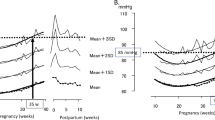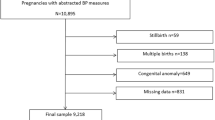Abstract
The significance of ambulatory blood pressure (ABP) monitoring during pregnancy has not been established. We performed a prospective study to elucidate whether ABP measures are associated with small-for-gestational-age birth weight (SGA). We studied 146 pregnant women who were seen for maternal medical checkups or suspected hypertension. ABP monitoring was performed for further assessment of hypertension. The outcome measure was SGA. The subjects were classified by their medical history and ABP as having preeclampsia or gestational hypertension (n=68 cases), chronic hypertension (n=48) or white-coat hypertension (n=30). There were 50 (34.2%) cases of SGA by the fetal growth reference standard. In multivariable logistic regression analyses adjusting for age, body mass index, the presence of prior pregnancy, current smoking habit and the use of antihypertensive medications, 24-h SBP (per 10 mm Hg (odds ratio (OR): 1.74; 95% confidence interval (CI): 1.28–2.38; P<0.001)) was more closely associated with SGA than clinic BP (OR: 1.40; 95% CI: 0.92–2.13; P=0.11). The results were essentially the same if 24-h BP was replaced by awake or sleep SBP. Ambulatory diastolic BP showed the same tendency. However, abnormal circadian rhythm was not associated with the outcome. In conclusion, ambulatory BP monitoring measures performed during pregnancy were more closely associated with SGA than clinic BP.
This is a preview of subscription content, access via your institution
Access options
Subscribe to this journal
Receive 12 digital issues and online access to articles
$119.00 per year
only $9.92 per issue
Buy this article
- Purchase on Springer Link
- Instant access to full article PDF
Prices may be subject to local taxes which are calculated during checkout



Similar content being viewed by others
References
Pickering TG . How should blood pressure be measured during pregnancy? J Clin Hypertens (Greenwich) 2005; 7: 46–49.
Pickering TG, Hall JE, Appel LJ, Falkner BE, Graves J, Hill MN et al. Recommendations for blood pressure measurement in humans and experimental animals: part 1: blood pressure measurement in humans: a statement for professionals from the subcommittee of professional and public education of the American Heart Association council on high blood pressure research. Circulation 2005; 111: 697–716.
Bellomo G, Narducci PL, Rondoni F, Pastorelli G, Stangoni G, Angeli G et al. Prognostic value of 24-hour blood pressure in pregnancy. JAMA 1999; 282 (15): 1447–1452.
Brown MA, Bowyer L, McHugh L, Davis GK, Mangos GJ, Jones M . Twenty-four-hour automated blood pressure monitoring as a predictor of preeclampsia. Am J Obstet Gynecol 2001; 185 (3): 618–622.
Kyle PM, Clark SJ, Buckley D, Kissane J, Coats AJ, de Swiet M et al. Second trimester ambulatory blood pressure in nulliparous pregnancy: a useful screening test for pre-eclampsia? Br J Obstet Gynaecol 1993; 100 (10): 914–919.
Vollebregt KC, Gisolf J, Guelen I, Boer K, van Montfrans G, Wolf H . Limited accuracy of the hyperbaric index, ambulatory blood pressure and sphygmomanometry measurements in predicting gestational hypertension and preeclampsia. J Hypertens 2010; 28 (1): 127–134.
Waugh J, Perry IJ, Halligan AW, de Swiet M, Lambert PC, Penny JA et al. Birth weight and 24-hour ambulatory blood pressure in nonproteinuric hypertensive pregnancy. Am J Obstet Gynecol 2000; 183 (3): 633–637.
Zhang J, Klebanoff MA, Roberts JM . Prediction of adverse outcomes by common definitions of hypertension in pregnancy. Obstet Gynecol 2001; 97 (2): 261–267.
Steer PJ, Little MP, Kold-Jensen T, Chapple J, Elliott P . Maternal blood pressure in pregnancy, birth weight, and perinatal mortality in first births: prospective study. BMJ 2004; 329 (7478): 1312.
Liro M, Gąsowski J, Wydra D, Grodzicki T, Emerich J, Narkiewicz K . Twenty-four-hour and conventional blood pressure components and risk of preterm delivery or neonatal complications in gestational hypertension. Blood Pressure 2009; 18 (1-2): 36–43.
Tranquilli AL, Giannubilo SR, Dell'Uomo B, Corradetti A . Prediction of gestational hypertension or intrauterine fetal growth restriction by mid-trimester 24-h ambulatory blood pressure monitoring. Int J Gynaecol Obstet 2004; 85 (2): 126–131.
Brown MA, Davis GK, McHugh L . The prevalence and clinical significance of nocturnal hypertension in pregnancy. J Hypertens 2001; 19 (8): 1437–1444.
Maggioni C, Cornélissen G, Otsuka K, Halberg F, Consonni D, Nicolini U . Circadian rhythm of maternal blood pressure and fetal growth. Biomed Pharmacother 2005; 59, Supplement 1 (0): S86–S91.
Kario K, Pickering TG, Matsuo T, Hoshide S, Schwartz JE, Shimada K . Stroke prognosis and abnormal nocturnal blood pressure falls in older hypertensives. Hypertension 2001; 38: 852–857.
Olofsson P, Poulsen H . Reversed circadian blood pressure rhythm preserves fetal growth in preeclamptic pregnancy. Eur J Obstet Gynecol Reprod Biol 1997; 75 (2): 133–138.
Sato K . A Proposal for A New Definition and Classification of ‘Pregnancy induced Hypertension (PIH)’ (2004). Medical View Co.: Tokyo, Japan, 2005.
Ogihara T, Kikuchi K, Matsuoka H, Fujita T, Higaki J, Horiuchi M et al. The Japanese society of hypertension guidelines for the management of hypertension (JSH 2009). Hypertens Res 2009; 32 (1):): 3–107.
Palatini P, Frigo G, Bertolo O, Roman E, Da Cortà R, Winnicki M . Validation of the A&D TM-2430 device for ambulatory blood pressure monitoring and evaluation of performance according to subjects' characteristics. Blood Press Monit 1998; 3 (4): 255–260.
Shimamoto K, Ando K, Fujita T, Hasebe N, Higaki J, Horiuchi M et al. The Japanese society of hypertension guidelines for the management of hypertension (JSH 2014). Hypertens Res 2014; 37: 253–292.
Taylor RS, Gamble G, McCowan L, North RA . Sleep effects on ambulatory blood pressure measurements in pregnant women. Am J Hypertens 2001; 14 (1): 38–43.
Shinozuka N, Okai T, Kohzuma S, Mukubo M, Shih CT, Maeda T et al. Formulas for fetal weight estimation by ultrasound measurements based on neonatal specific gravities and volumes. Am J Obstet Gynecol 1987; 157 (5): 1140–1145.
Meyer NL, Mercer BM, Friedman SA, Sibai BM . Urinary dipstick protein: a poor predictor of absent or severe proteinuria. Am J Obstet Gynecol 1994; 170 (1 Pt 1): 137–141.
Brown MA, Lindheimer MD, de Swiet M, Van Assche A, Moutquin JM . The classification and diagnosis of the hypertensive disorders of pregnancy: statement from the International Society for the Study of Hypertension in Pregnancy (ISSHP). Hypertens Pregnancy 2001; 20 (1): IX–XIV.
DeLong ER, DeLong DM, Clarke-Pearson DL . Comparing the areas under two or more correlated receiver operating characteristic curves: a nonparametric approach. Biometrics 1988; 44: 837–845.
Peek M, Shennan A, Halligan A, Lambert PC, Taylor DJ, De Swiet M . Hypertension in pregnancy: which method of blood pressure measurement is most predictive of outcome? Obstet Gynecol 1996; 88 (6): 1030–1033.
Metoki H, Ohkubo T, Imai Y . Diurnal blood pressure variation and cardiovascular prognosis in a community-based study of Ohasama, Japan. Hypertens Res 2010; 33 (7): 652–656.
Boggia J, Li Y, Thijs L, Hansen TW, Kikuya M, Björklund-Bodegård K et al. Prognostic accuracy of day versus night ambulatory blood pressure: a cohort study. Lancet 2007; 370 (9594): 1219–1229.
Bellomo G, Venanzi S, Saronio P, Verdura C, Narducci PL . Prognostic significance of serum uric acid in women with gestational hypertension. Hypertension 2011; 58 (4): 704–708.
Arioz D, Saglam H, Demirel R, Koken G, Cosar E, Sahin F et al. Arterial stiffness and dipper/nondipper blood pressure status in women with preeclampsia. Adv Ther 2008; 25 (9): 925–934.
Kario K . Proposal of a new strategy for ambulatory blood pressure profile-based management of resistant hypertension in the era of renal denervation. Hypertens Res 2013; 36: 478–484.
Silver HM, Tahvanainen KUO, Kuusela TA, Eckberg DL . Comparison of vagal baroreflex function in nonpregnant women and in women with normal pregnancy, preeclampsia, or gestational hypertension. Am J Obstet Gynecol 2001; 184 (6): 1189–1195.
Coca A . Circadian rhythm and blood pressure control: physiological and pathophysiological factors. J Hypertens Suppl 1994; 12 (5): S13–S21.
Ekholm EM, Polo O, Rauhala ER, Ekblad UU . Sleep quality in preeclampsia. Am J Obstet Gynecol 1992; 167 (5): 1262–1266.
Krielessi V, Papantoniou N, Papageorgiou I, Chatzipapas I, Manios E, Zakopoulos N et al. Placental pathology and blood pressure's level in women with hypertensive disorders in pregnancy. Obstet Gynecol Int 2012; 2012: 6.
Brown MA, Mangos G, Davis G, Homer C . The natural history of white coat hypertension during pregnancy. Br J Obstet Gynaecol 2005; 112 (5): 601–606.
Brown MA . Is there a role for ambulatory blood pressure monitoring in pregnancy? Clin Exp Pharmacol Physiol 2014; 41 (1): 16–21.
Iwasaki R, Ohkuchi A, Furuta I, Ojima T, Matsubara S, Sato I et al. Relationship between blood pressure level in early pregnancy and subsequent changes in blood pressure during pregnancy. Acta Obstet Gynecol Scand 2002; 81 (10): 918–925.
Hirashima C, Ohkuchi A, Arai F, Takahashi K, Suzuki H, Watanabe T et al. Establishing reference values for both total soluble fms-like tyrosine kinase 1 and free placental growth factor in pregnant women. Hypertens Res 2005; 28 (9): 727–732.
Levine RJ, Lam C, Qian C, Yu KF, Maynard SE, Sachs BP et al. Soluble endoglin and other circulating antiangiogenic factors in preeclampsia. N Engl J Med 2006; 355 (10): 992–1005.
Ohkuchi A, Hirashima C, Matsubara S, Suzuki H, Takahashi K, Arai F et al. Alterations in placental growth factor levels before and after the onset of preeclampsia are more pronounced in women with early onset severe preeclampsia. Hypertens Res 2007; 30 (2): 151–159.
Hirashima C, Ohkuchi A, Matsubara S, Suzuki H, Takahashi K, Usui R et al. Alteration of serum soluble endoglin levels after the onset of preeclampsia is more pronounced in women with early-onset. Hypertens Res 2008; 31 (8): 1541–1548.
Meidahl Petersen K, Jimenez-Solem E, Andersen JT, Petersen M, Brødbæk K, Køber L et al. β-Blocker treatment during pregnancy and adverse pregnancy outcomes: a nationwide population-based cohort study. BMJ Open 2012; 2 (4):e001185.
Acknowledgements
We gratefully acknowledge Ms Kimiyo Saito, Hideko Taguchi, Kaori Kobayashi, Mika Kunimatsu and Miki Sato for the ABPM examination and data management of this study.
Author information
Authors and Affiliations
Corresponding author
Ethics declarations
Competing interests
The authors declare no conflict of interest.
Additional information
Supplementary Information accompanies this paper on the Journal of Human Hypertension website
Supplementary information
Rights and permissions
About this article
Cite this article
Eguchi, K., Ohmaru, T., Ohkuchi, A. et al. Ambulatory BP monitoring and clinic BP in predicting small-for-gestational-age infants during pregnancy. J Hum Hypertens 30, 62–67 (2016). https://doi.org/10.1038/jhh.2015.20
Received:
Revised:
Accepted:
Published:
Issue Date:
DOI: https://doi.org/10.1038/jhh.2015.20
This article is cited by
-
Masked hypertension and neonatal outcome in high-risk pregnancies
Journal of Human Hypertension (2023)
-
Development of preeclampsia in pregnant women with white-coat hypertension: a systematic review and meta-analysis
Archives of Gynecology and Obstetrics (2023)
-
Hypertensive disorders of pregnancy: definition, management, and out-of-office blood pressure measurement
Hypertension Research (2022)
-
Out of Office Blood Pressure Measurement in Pregnancy and the Postpartum Period
Current Hypertension Reports (2018)
-
Monitoring and evaluation of out-of-office blood pressure during pregnancy
Hypertension Research (2017)



